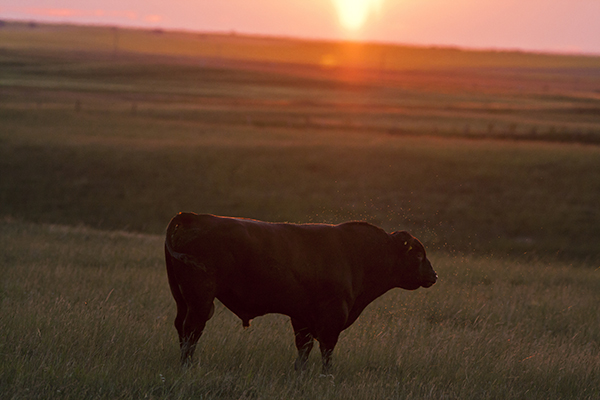AB Direct - Steers
Rail: 475.00-485.00 del
AB Direct - Heifers
Rail: 475.00-485.00 del
US Trade- Steers
Rail: 330.00 (IA, NE)
US Trade - Heifers
Rail: 330.00 (IA, NE)
Canadian Dollar
0.27

Moderation is key: Tips for identifying a balanced herd bull
Weaning weights, crop yields, pie à la mode… bigger is always better, right?! It’s an easy decision when pie is involved, but the answer to everything else is a resounding “maybe.”
Annual reports from the Canadian Cow-Calf Cost of Production Network and a recent article from the Beef Cattle Research Council (Big Cows and Big Questions) advise that optimization, not maximization, is the key to profitability and sustainability. But how do you keep mature cow body weight in check when evaluating your next herd bull as a yearling? They aren’t even fully grown themselves! Never mind that different breeds mature at different ages. This means an Angus, Simmental and Hereford bull all sharing the same birth date and weighing the exact same at one year of age could mature to drastically different end weights.
Luckily, most breed associations report Expected Progeny Differences (EPDs) such as mature weight and mature height. This is actually a measurement of the bull’s genetic potential to influence the mature weight (expressed in pounds) or mature height (expressed in inches) of his daughters, rather than a reflection of his current frame size or body weight. If you have a terminal-crossed Charolais herd and sell calves off the cow at weaning, then a bigger number may make both sense and cents for you! However, if your goal is to maintain low-input, maternal, herd-producing, moderate replacement heifers, you should limit your pool of candidates to those that are equal to or even below breed average.
Take a look at how average mature weight has changed over the last 50 years. This dataset is reported by the American Angus Association; however, trends are similar across the North American beef industry. In the last five decades, average mature weight increased by more than 150 lbs! Maybe that statistic isn’t all that surprising in itself, but I always find it interesting to see how much selection pressure can influence certain traits.
Unfortunately, a lot of valuable information needs to be crammed into very little real estate in bull sale catalogues, which means there isn’t always room to report EPDs outside the standard BW, WW, YW, CE, Milk, etc. Be sure to reference the bull’s full set of EPDs via the respective breed association website using the bull’s tattoo or registration number if you need more data to make an informed decision.
Another good parameter to critically evaluate that often makes the cut for most bull sale catalogues is the milk EPD. Milk is typically categorized as a maternal EPD; however it’s technically more of a performance trait. This EPD is expressed in pounds of calf weaning weight attributed to milk production. So, a daughter sired by a bull with a milk EPD of 30 would wean calves 10 lbs heavier on average compared to those sired by a bull with a milk EPD of 20. As we’ve selected for more growth in our calves and heavier weaning weights over the last five decades, milk production has trended upward. Unfortunately, milk production is positively associated with increased feed costs and negatively associated with fertility. An extreme example of this is the dairy industry. While they boast exceptional milk production, conception rates after a single round of AI are teetering around 40 per cent.
Regarding the beef industry, maybe the saying should be, “You can’t have your milk and drink it too.” Ranches operating in rugged environments with low inputs literally cannot afford to swing the pendulum too far on milk. The added pounds of product at weaning may not compensate for the added pounds of feed that went into the factory. It takes the right environment and the right nutrition program to make this one pencil out, so proceed with caution and make sure you research breed averages before sale day.
My last example of “bigger isn’t always better” is scrotal circumference. Scrotal circumference is highly correlated with serving capacity and age of sexual maturity in offspring. Scrotal circumference is also highly heritable, which means it’s relatively easy to influence genetic change. For this reason, we strictly cull based on breed minimums standardized by age. So, what’s the big deal about a larger scrotal circumference? (No pun intended.) My concern stems from when a bull’s measurement is artificially inflated by excessive amounts of fat in the scrotum. This is a hard one to sort out.
As you peruse the yard on sale day and ask bulls to rise from their vast mountains of straw, you may have to use body condition score as a proxy for scrotal fat. Theoretically, if I had two 14-month-old bulls to choose from—one developed in a confined feeding operation with a BCS = 4/5 and a SC of 38cm and one developed in a forage-based operation with a BCS = 3/5 and a SC of only 36cm—I would select the latter. Genotypically, their true scrotal measurements are probably fairly similar with the same genetic potential to pass on good fertility to their daughters, but with the latter bull I don’t expect any complications from overconditioning. Research has proven bulls carrying excessive scrotal fat have impaired thermoregulation, which can negatively impact semen quality down the road. Furthermore, overconditioning has been linked to abnormal hoof growth and laminitis, cartilage defects in joints and other metabolic diseases that can limit your new investment’s longevity in the herd.
Veterinarians may recommend palpating the testicles on those early sale bulls before turn-out and fully retesting if any abnormalities are found. Occasionally we find a bull has lost ~1-2 cm since the time of sale, sometimes due to fat loss, sometimes due to degeneration. However, it’s far better to identify any issues pre-breeding when most yearlings are still covered under insurance, as compared to preg-check day. A bull is often described as a breeding athlete. We can’t treat them like a couch potato ten months out of the year and expect them to perform for the remaining two.
Like most things in life, when selecting your next herd sire, moderation is key for most traits. Finding the middle of the road often translates to more total miles.
This article was first published in Volume 5 Issue 1 of ABP Magazine (February 2025). Watch for more digital content from the magazine on ABP Daily.


